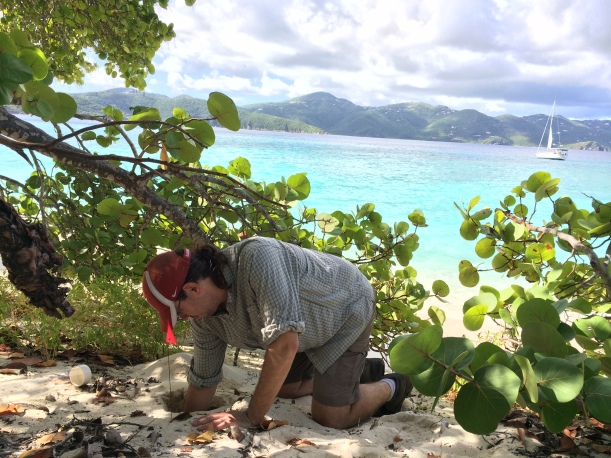Gail and I recently visited Guana Island in the British Virgin Islands as part of an ongoing research project by the Langkilde Lab to study how invasive Red Imported Fire Ants may be spreading across and affecting the biota of this amazing island (see here for Tracy’s recap of last year’s work). In a few weeks, we’ll post an account of our trip and the research that we did, but for now, I’m just going to throw out the eye-candy…all the cool herps that we got to see and catch!
While Guana is a small island (only 850 acres…it’s teeny), it is home to an over-sized diversity of flora and fauna, including herps, and especially lizards (our specialty!).

Walking down to our study area on our first morning, we stumbled across this track…lizard or dinosaur?
There are three different species of anoles on the island (though I only grabbed pics of two):

A crested anole (Anolis cristatellus) warily eying me while I was looking for fire ant mounds. These fellas are quite common and easily spotted since they take up prominent positions on tree trunks around the island while defending their territories. This one has a decent sized crest on its tail but some a truly spectacular.

A saddled anole (Anolis stratulus) displaying his brightly colored dewlap while posing on a tree limb. These lizards are often found on trunks on many islands in the Caribbean, but on Guana, because there are few competing species, they can be found on both tree trunks and the ground.

An itsy-bitsy hatchling saddled anole that Gail snagged in our walks over the island. It’s almost transparent!
The final anole species, Anolis pulchellus, is a grass anole that inhabits some of the more vegetated parts of the island. I saw three of these, including one sleeping while clinging to a branch, but in each case, I either didn’t have a camera handy or the anole was not willing to sit still to have its portrait made.
Guana’s most famous lizard is the highly endangered Stout Iguana (Cyclura pinguis). Just 30 years ago, there were fewer than 200 individuals of this species thought to occur in the world, and they were only located in one place: Anegada Island (part of the BVI). As part of Guana restoration efforts, Skip Lazell and the The Conservation Agency worked to restore iguana populations on Guana Island by transplanting some individuals from Anegada. This population is now doing well, with lots of adults and successful yearly reproduction. While we were there, other researchers had caught over 100 hatchlings born this year alone!

Large adults are commonly seen on the trails and make quite a racket as they go motoring through the brush. This one paused to express its displeasure with our disruption of its basking by bobbing its head at us. While this iguana breaks 10 lbs, some individuals over 40 lbs occur on Guana!

Hatchling stout iguanas were a common site on the island, especially around the orchard where we found this little tyke. The orchard provides lots of tasty fruits that allow hatchling igaunas to more than double their weight in their birth year. This one attempted to make a short dash up a tree away from me, but I got a quick snap of him peeking out from behind some foliage before I left him to his own devices.
Aside from the lizards, there are also two snake species on Guana. We spotted many individuals of one species, often called the Puerto Rican racer (Alsophis portoricensis) as they are active, diurnal hunters. We saw adults and hatchlings in the undergrowth or zipping across the dirt roads of the island.

The babies were quite cute with a pale yellow chinstripe.
Possibly the most dramatic wildlife moment I experienced on the trip involved the predation of a racer on a hatchling stout iguana (though I’ll have to narrate it as I was doing laundry at the time of the observation and, of course, not carrying a camera!). After a walk in search of walking sticks (the insect, not old people kind), I was called over to the main complex building to see a struggle to the death! A very large (pushing one meter in length) racer had snagged a hatchling stout iguana which had wandered into the “living room” of the resort. The snake had envenomated the lizard with a bite to the chest and surrounded the hatchling with its coils to hold it while the venom had its way with the lizard’s physiology. Upon seeing us, however, the snake released its potential prey and fled through the far door of the room. After a little while the lizard began slowly staggering around the living room and looked not long for the island, so we moved on to give the snake a second chance at a meal.
In the morning, the living room revealed a scene worthy of CSI. A trail of dried blood spiraled across the floor of the living room (presumably from the bite wound on the hatchling’s chest). As the trail approached the exit to the room, it suddenly became a tangled smear with a sizable pile of iguana poop at the end (perhaps a last ditch defensive mechanism?). Apparently this was the scene of the hatchling’s last stand (and the snake’s dinner buffet). While it’s sad to see a hatchling of a critically endangered species (maybe only 500 or so in the world!) meet its end, I found it encouraging to see that the species has recovered on Guana to the point where it is resuming its natural place in the ecosystem. Hatchling iguanas are important food sources for snakes and bird of prey, and, with the extent of reproduction for the stout iguanas on Guana Island, this reintegration of the species into the energy flow of the island is a good sign that the iguana is being reintegrated into its native ecosystem.
Lest I forget, there’s also one frog species on the island, Eleutherodactylus antillensis. This species is known locally as the Bo-peep Frog, as one of its calls sound a bit like Bo-Peep!

As soon as the slightest bit of rain would fall, these frogs would sprout into chorus all over the island, providing a relaxing soundtrack to the lovely tropical evenings.
There were, of course, many other amazing species present on the island, including some that we actually studied! You’ll have to wait to hear from Gail about our research, but I’ll leave you with one more photo:

Yup. That’s a tarantula (Cyrtopholis bartholomei)





































